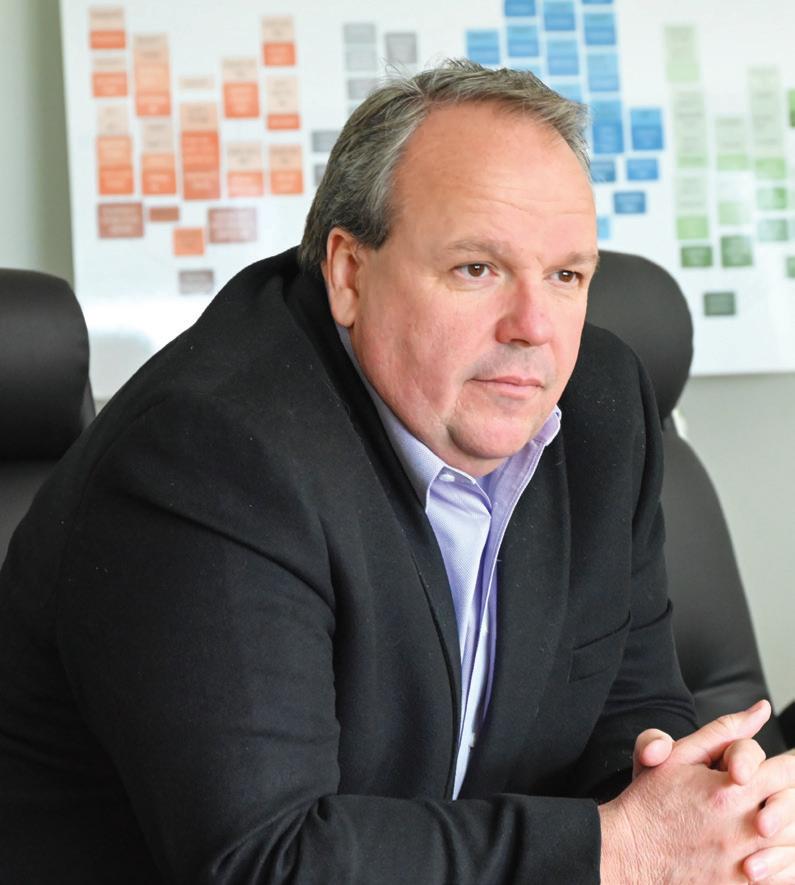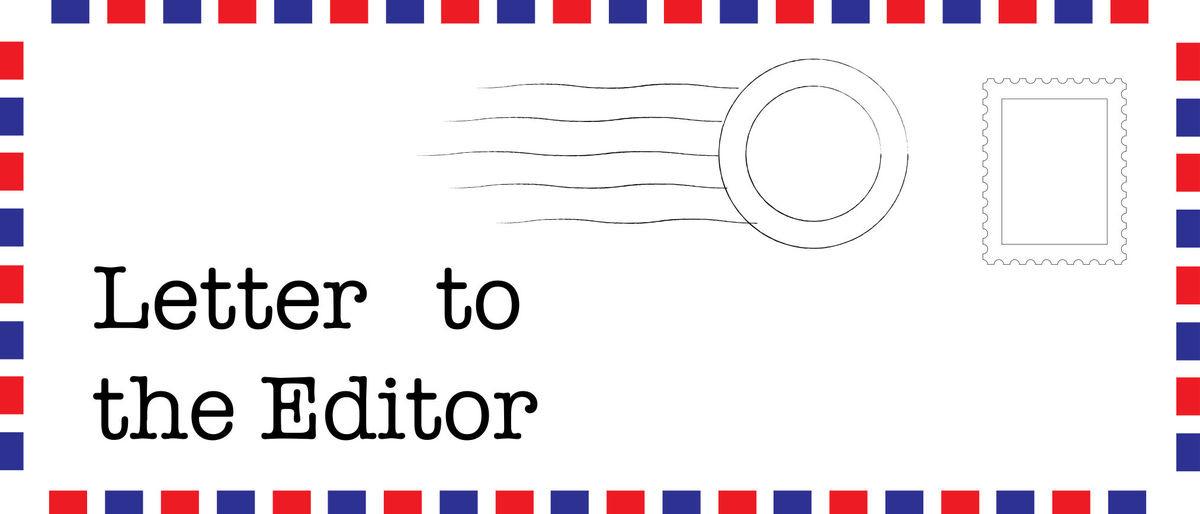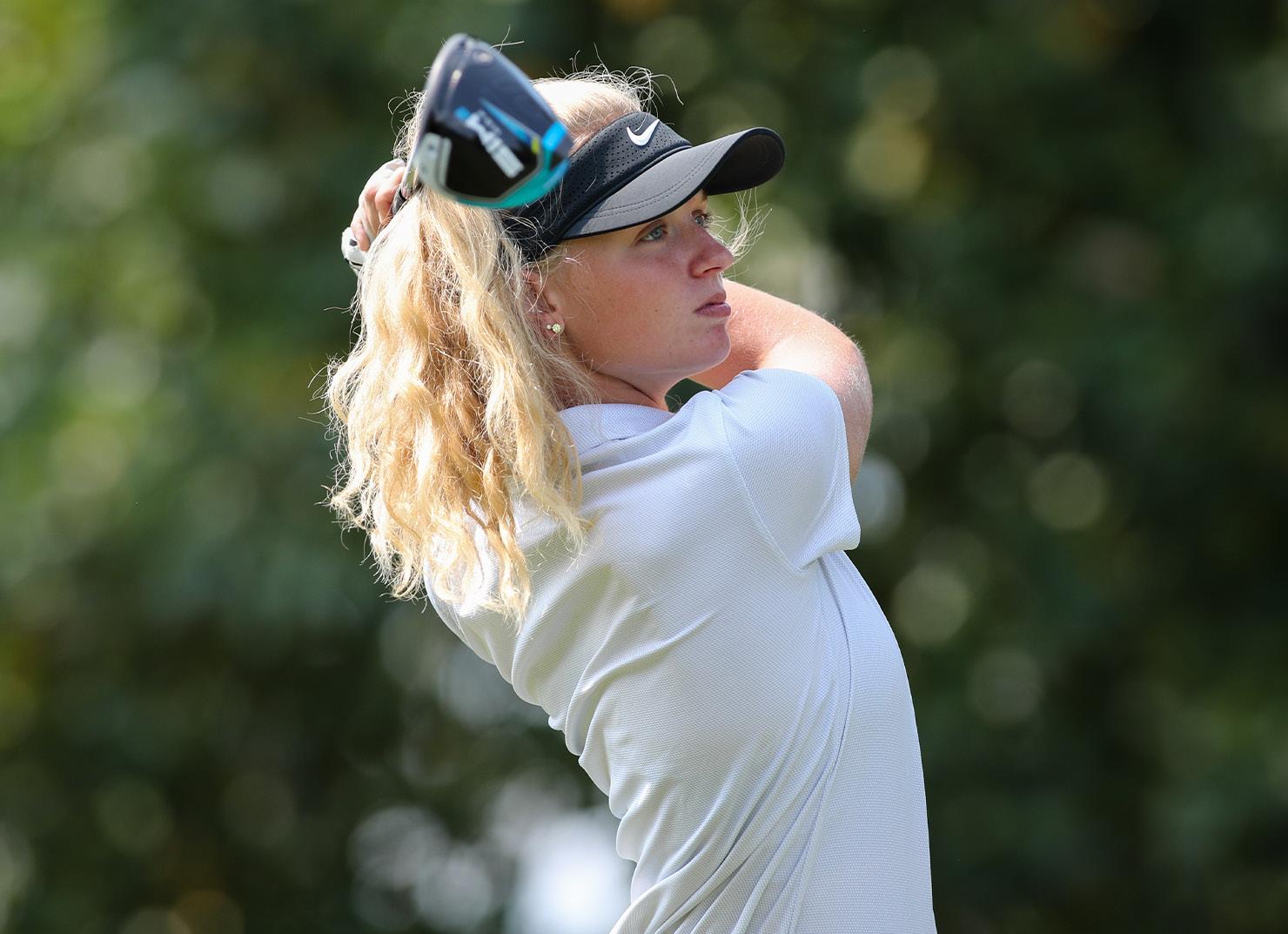
11 minute read
‘Heart and soul’
from The Breeze 2.2.23
by The Breeze
Oasis artist puts on solo woodworking show that highlights natural beauty
By SABINE SOLTYS contributing writer
Advertisement
Woven woodwork and twigs intertwine to create a large, lifelike praying mantis. It’s one of John Robson’s many works that can be found at Oasis Fine Arts and Crafts in downtown Harrisonburg.
At Oasis, Robson is putting on a solo show called “Sawmills, Driftwoods and Twigs,” which will be on display till Feb. 12. Currently, there are pieces such as “The Swamp Thang” — the praying mantis — and handcrafted wooden mirrors and tables on display.
As a woodworker, Robson, 78, has been creating and selling pieces like the praying mantis since 1976, when he got his Virginia sales tax license. It was during this time that he worked for Contemporary Workshop, a small vocational rehabilitation program that worked mostly with high school-aged kids. The goal of programs like these is to help people become more equipped to return to the workforce or to be more independent in general, according to a Grand Canyon University blog. According to Robson, the program, based in Fairfax County, taught and provided kids with educational and life skills that they could then apply out in the world.

Robson said he originally started as the woodworking supervisor and later became the assistant director of the program. As the woodworking supervisor, Robson said he taught students how to make rectangular wooden school blocks. After the company closed in 1974, Robson opened his own undercover workshop — there were strict business regulations, he said — in Fairfax to create pieces to sell at craft shows. As he continued to develop this workshop, he decided to name his business The Standing People. As a woodworker, Robson focuses on making furniture that he then displays at craft shows and in Oasis.
“‘The Standing People’ is an Indian phrase for trees, and in the Lakota Sioux language, all the natural kingdoms were people,” Robson said. “There was the swimming people, the flying people and the standing people … and I feel that way about the trees, and I hope in my work that will rub off a little.”
Robson moved to the Shenandoah Valley in 1981 and started his own craft show with his wife, Sue, in Timberville, Virginia, soon after. For two weekends in October, they hosted the show on their property, known as the Barn Show, where Robson sold his work and invited other select artists to participate. The Barn show lasted for 32 years until Robson and his wife decided to discontinue it five years ago due to the amount of time and effort it took to put the show together.
Fellow artist and volunteer at Oasis, Barbara Paul, first met and learned of Robson during this show in the 1990s. She said she loves the real, natural look Robson brings to the wood and appreciates how he makes the beauty of the piece come out.
“When I look at his work, I always want to touch it because the wood is just so beautiful, and it makes me want to be out in the woods and makes me want to go out and appreciate trees more,” Paul said.
Paul has been a member of Oasis since fall 2018, volunteering and showcasing her own jewelry. Alongside 35 other artists, Paul gives her time to keep the gallery running, including overseeing shows like Robson’s.
When Robson first showed his work at Oasis last May, he recaught the eye of Brenda Fairweather, who’s in charge of finding artists for the rotating Oasis shows.
Fairweather has been a member of Oasis since 2006, selling pottery and baskets. In addition, with a lot of organizing, collaborating and communicating, Fairweather said she works hard to put together the lineup of artisans who’ll be featured at Oasis a year in advance. While Fairweather first met Robson eight years ago participating in his own show, she said she desired to get his work exhibited at Oasis, even though he’s not a member or volunteer at Oasis.
“His technique and quality of work is so special that when a piece of his work is in your presence, it just feels like he is in your presence,” Fairweather said. “His heart and soul are in it. His work inspires me to make changes to what I do, to become better at making pottery or baskets.”
After filling the schedule with Oasis members first, Fairweather met with the board to pitch Robson joining the gallery. Oasis focuses on artisans the board and its members know will bring people into the store and have historically done well with shows, and Robson was no exception.
“John had done so well in that group show in 2022 and we wanted someone who is successful and popular,” Fairweather said. “But we also asked him because of the quality of [his work] and who he is. People know him, so it draws people into Oasis.”
Robson said he wants to continue to participate in these shows in hopes it’ll let people know his own business is still alive after he stopped doing his own show. He said he loves the face-to-face interactions of showing his work.
For Robson, “setting up is no fun, taking down is no fun.” He loves the moments in between.
He said the atmosphere of letting customers choose what they want, and discussing the history of the individual pieces is his favorite part.
“This whole idea of buying local and having individual people making your work and wanting to know where your items come from and ‘know the maker,’ — that’s it, that’s us in a nutshell,” Paul said of Oasis. “We allow more of a connection to the arts of the community.”
CONTACT Sabine Soltys at soltysms@dukes.jmu.edu. For more on the culture, arts and lifestyle of the JMU and Harrisonburg communities, follow the culture desk on Twitter and Instagram @Breeze_Culture.
Among other qualities, adjunct voice instructor David Newman is known for wearing his “signature rainbow suspenders,” Rachel Tan, one of his students said. Photos by Savannah Reger / The Breeze

Out-of-the-box music instructor beloved for endearing nature, eccentricity HIS OWN TUNE
By GRANT JOHNSON The Breeze
David Newman keeps two phones: One for texting, calling and the sort, and the other for sticking halfway down his throat.
With a wide-open mouth, Newman lowers a disinfected 6.24-by-3.08-inch iPhone 8 — with its video and flash on but no phone case — down far enough to illuminate his vocal folds, which are located inside the Adam’s apple at the bottom of his throat. He’s checking if his folds are white, he said. If pink, he might have laryngitis, which means the vocal folds are swollen and his voice sapped.

For Newman, tip-top vocal folds are crucial. The adjunct voice instructor at JMU also performs oratorio — singing onstage with music — typically in front of 500-3,000 people along the East Coast once a month for a minimum fee of $1,000 per performance.
Checking for laryngitis with his phone saves him more money than visiting a laryngologist does, Newman said, and an endoscope makes him gag. In a follow-up email to The Breeze, he said he’s not trying to avoid going to the doctor by scoping himself. However, Newman said he doesn’t know anyone else who checks on their vocal folds with an iPhone.
“This is a boundary that I think a lot of people have set for themselves,” Newman said. “They go to a doctor, and the doctor does this and they don’t think, ‘Oh, someone did this by themselves, maybe I could do that.’”
Newman sometimes misses his Friday morning classes when traveling for his oratorio performances. But when he’s teaching in JMU’s Music Building, students paint him as a lighthearted and eccentric professor with a soft side.
“He always wears his signature rainbow suspenders, and I love him for that,” Rachel Tan, a junior music performance major who’s had class with Newman for three semesters, said. “What an iconic ally.”
Erin Dixon (’20), a former student of Newman’s and now a music teacher at Hanover High School in Richmond, Virginia, said Newman was the most caring professor she’s had in the Music Building. Before teaching Dixon, Newman once stopped her in the Music Building’s hallway because it looked like something bothered her. Dixon said Newman gave her a hug.
“Every major is hard, but being a music major is very hard, and he was always someone who I felt genuinely cared about how we were doing,” Dixon said, “like, mentally aside from being a student, like how we were doing as people.”
When Newman is in class, every day is songs to analyze their texture, rhythm, melodies and harmonies. Another time, Tan said, the students decided to sit on the floor. For one class last year, which happened to be April Fool’s Day, Tan said, only four people showed up. When Newman arrived, Tan recalled him saying, “Hmm, let’s go to Dunkin’ Donuts” and sending out a Canvas announcement that read, “For anyone who’s coming to class late, we’re at Dunkin’ Donuts.” The tradition halted during the pandemic, but whenever six or fewer students show up to class, Newman will take them to the Dunkin’ inside the Student Success Center (SSC) for a dozen assorted donuts on his dime.
Newman’s spontaneity is instilled in Dixon’s teaching methods at her high school, she said, but it’s hard to replicate.
“I try to always be energetic in my classroom and do similar things — keep things fun and keep things exciting — especially when dealing with high schoolers,” Dixon said. “You have to keep it fun or they don’t care. But he’s just so special that it’s something I won’t really ever be able to capture.”
Newman himself molds his teaching methods from the best qualities of his biggest influencers and coaches, namely Stefan Young, one of his music teachers growing up. Young, who taught aural skills, music theory and composition, often tasked Newman and his classmates with a “ridiculously hard thing,” Newman said, but kept a smile on his face as he simply asked students to try their best.
Next up, Newman’s work to support choirs during the peak of COVID-19 will be featured in the documentary “The Drive to Sing” at a showing in Hartman Hall on Feb. 25. Newman doesn’t expect his students to fit a phone in their mouths, or to be a music-hearing “whiz,” as Dixon described him. Newman said he doesn’t look too closely at teaching evaluations because he’s learned he’s at his best in the classroom when he stays true to himself.
“We sure don’t get paid well enough not to have fun,” Newman said. “So, I hope that we don’t just approach it as some task that we have to do, but that we remember we do music for a reason, and to find wonder in that — to find the joy in that.”
Thursday, February 2, 9 CULTURE
By MORGAN VUKNIC The Breeze
Black Resistance: This is the theme of Black History Month for 2023, which will celebrate how Black people have resisted oppression for centuries. In honor of Black History Month, there are many events being held on campus that honor the theme and celebrate Black culture and history.

Center for Multicultural Student Services (CMSS) events
Black History Month First Friday
To kick off Black History Month, CMSS is hosting First Friday on Feb. 3 from 3-5 p.m. in SSC suite 1312. “Black History Month provides all Americans the opportunity to celebrate the rich culture, heritage and achievements of black people,” says the CMSS website. “When we study and recognize Black History, we study ourselves and our national history.”
Black History Month
DEEP Impact diversity dialogue
Twice a month, Diversity Education Empowerment Program (DEEP) Impact hosts diversity dialogues “for students to join in conversation around topics relating to identity, culture, and justice,” according to its website. On Feb.15 at 7 p.m. in The Union Ballroom, DEEP Impact will be hosting its next diversity dialogue, focusing solely on Black History Month.
Restorative Justice Workshop with Assata Lewis: We Are What We Need
In partnership with the Office of Student Accountability and Restorative Practices (OSARP), CMSS will welcome Assata Lewis to campus. The education consultant and restorative justice practitioner will be leading a workshop titled “We Are What We Need” on
Feb. 22 at 6 p.m. in The Union room Taylor 404. It will focus on restorative justice and practices and is open to all students, faculty and staff. The link to register can be found on CMSS’ website.
Black History Month
speaker Ayannah Johnson
CMSS will be partnering with the Honors College to host speaker Ayannah Johnson on Feb. 23 at 7 p.m. in The Union Ballroom. Johnson is the senior director of diversity, equity and inclusion (DEI) at Ampersand, a television advertising, sales and technology company. She’s also the CEO of Johnson and Associates Consulting LLC, a DEI consulting group. Her work includes providing organizations with strategic plans, working with higher-ups to ensure they’re including DEI efforts in decision-making, ensuring employees feel seen and heard and traveling around the country presenting to schools, nonprofits and corporations about topics related to diversity.
Additional on-campus events
Furious Flower Poetry Center workshop and reading Furious Flower, the first academic center for Black poetry in the country, will be hosting a workshop and live reading from Shara McCallum in collaboration with JMU’s African, African American and Diaspora Studies (AAAD) Center on Feb. 17. McCallum is a Jamaican author and poet and winner of the 2022 Hurtson/Wright Legacy Award for Poetry and a finalist for the 2022 UNT Rilke Prize. The workshop, open only to faculty and staff, will take place from 12-1:15 p.m. in Pathways in the Wine Price building. After the reading, McCallum will be doing a Q&A session, reading and book signing in the Festival Highlands Room, which will be livestreamed on Facebook.

Black Excellence Gala
Hosted by JMU’s National Association for the Advancement of Colored People (NAACP) chapter and Black Student Alliance, the Black Excellence Gala will take place Feb. 17 from 7-9 p.m. in the Hall of Presidents located on the third floor of D-Hall. The black-tie event will feature awards that recognize students, faculty and staff for “their efforts in the advancement of and providing a community for the Black commonwealth of James Madison University,” according to the event’s registration form. The last day to register for the gala is Feb. 10.
AAAD conference
The 13th annual African, African American and Diaspora Studies (AAAD) Center Interdisciplinary Conference will be held from Feb. 14-17 with the theme “Roots, Limbs and Leaves.” The conference will be in a hybrid format with the main sessions held in Festival Allegheny Room and an additional talk being held in the Festival Highlands Room. All disciplines are welcomed and topics such as Black geography, linguistic roots, climate justice, Black digital networks and religion are open to be discussed. Anyone’s welcome to attend, but registration is required.
Learn more about Black history

While there are many events happening on-campus to commemorate Black History Month, there are many ways to educate yourself on Black history and culture outside of February. Here are places in Harrisonburg and JMU where you can go to learn more.
Shenandoah Black Heritage Center
The Shenandoah Black Heritage Center is a nonprofit organization with the mission to “learn, share and illuminate the rich African-American history and culture of the Shenandoah Valley of Virginia,” according to its website. Made up of local historians, writers, artists, teachers and interested residents of Harrisonburg, the Center learns about Black history that’s often kept out of history books and then spreads knowledge to the community through programs and speakers.
Ruth and Lowell Toliver Collection of Newman Family Papers
During Black History Month in 2021, Ruth and Lowell Toliver donated their family’s papers to JMU Special Collections. These papers document the life of George Ambrose Newman (1855-1944), a Black educator in Harrisonburg. The collection details the community members, churches and schools of Harrisonburg’s historic African-American neighborhood, the Northeast Neighborhood.
Roots Run Deep: An African American History Tour
Roots Run Deep is a free walking tour of African-American history through Harrisonburg and the Zenda community. The tour, stemming from research from the Shenandoah Valley Black History Center, begins at Jail Hill, which is located at 176 W. Market St. and ends at Harry Lee’s Shoe Shine Parlor, located at 57 S. Main St. Maps and brochures for the tour are available on Roots Run Deep’s website.
Black History Month is an opportunity to highlight Black culture, and these events and locations are a great place to start when it comes to learning more about Black history.

CONTACT Morgan Vuknic at vuknicma@ dukes.jmu.edu. For more on the culture, arts and lifestyle of the JMU and Harrisonburg communities, follow the culture desk on Twitter and Instagram @Breeze_Culture.










